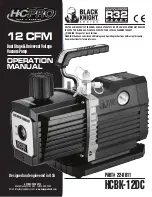
52
ARTC-SVX006A-EN
NOTICE
Coil Damage!
High pressure water from a power washer can
damage and distort the cooling fins on the coil.
Using a pressure washer on condenser coils is not
recommended. Damaged fins can adversely affect
chiller efficiency.
4. Clean coils by spraying water in the opposite direction
of the air flow, from top of the coil to the bottom. Spray
in a consistent pattern to work the dirt and debris from
the top to the lower part of the coil.
5. For extremely dirty coils, chemical soaking may be
required to loosen debris build-up. Apply chemicals
with a hand-held pump sprayer following a similar
pattern used in the water cleaning.
6. Let the chemical mixture soak in the heat exchanger for
a short period of time to loosen sediment and scale
build-up. Trane recommends using straight tap water
except in extreme cases. (Take extra precautions by
covering electrical components with plastic bags, etc.)
7. After chemical cleaning, all surfaces must be flushed
thoroughly with clean water to remove residual
chemicals. Trace chemical residue may result in
premature aluminum fin breakdown and deterioration
requiring coil replacement.
8. Securely reinstall fan grill assembly (or V-baffle end
cap).
9. Turn power back on individual unit after ensuring all
electrical connections are wiped dry.
10. Ensure that each unit’s panels are clean and clear of
debris.
Heat Exchanger Cleaning Procedure
Fouling of the heat exchangers will result in a gradual
decline in performance of the heat pump.
1. Isolate each heat exchanger using the isolation valves.
2. Back flush using the city water supply forced to a drain.
3. A brazed-plate heat exchanger is cleaned by back
washing which is forcing a cleansing water/glycol
mixture backwards through it at higher than normal
pressures.
4. Flushing should take place across a maximum 30 Mesh
screen filter/strainer with frequent screen cleaning to
remove the debris from the heat pump. Flushing should
continue until the screen is clean. After detergent and
chemical cleaning, flush the piping for a minimum of
one hour with fresh water to remove any remaining
cleaning compounds.
Compressor Tasks
The AXM air-to-water heat pump has been designed for
ease of maintenance access. When properly positioned
within a machine room or space, Copeland compressors
can be quickly removed for repair or replacement. (See
“Site Preparation and Clearances,” p. 13
Remove Compressor
Verify that power is turned OFF via the heat pump module
breaker that is found in the power distribution panel.
Confirm module power is OFF by testing with known
operational voltmeter. Once confirmed, install lockout/
tagout equipment to ensure power is not turned on while
service work is being performed.
WARNING
Hazardous Voltage!
Failure to disconnect power before servicing could
result in death or serious injury.
Disconnect all electric power, including remote
disconnects before servicing. Follow proper lockout/
tagout procedures to ensure the power can not be
inadvertently energized. Verify that no power is
present with a voltmeter.
1. Close the suction and discharge rotalock valves. Firmly
front-seat both rotalock valves clockwise.
Note:
Do not over-tighten as the valve can become difficult
to loosen if over-tightened.
2. Recover the remaining refrigerant charge from the
compressor using a suitable recovery machine and a
clean recovery cylinder that is pressure rated for the
refrigerant being removed. Weigh refrigerant charge
that was removed.
3. Remove all compressor electrical wiring, as well as
safety and crankcase heater wiring. Make sure to
notate all connection points for the new installation.
Note:
Be sure to document conductor/wire numbers and
their corresponding termination points.
4. Using a spud wrench, remove the rotalock nuts from
the compressor.
5. Remove the four compressor mounting bolts from
frame using two 1/2 inch sockets, or a socket and a
wrench. (Install the nuts underneath the frame.)
6. Remove the compressor from the module.
Install Compressor
Verify that power is disconnected from the heat pump.
WARNING
Hazardous Voltage!
Failure to disconnect power before servicing could
result in death or serious injury.
Disconnect all electric power, including remote
disconnects before servicing. Follow proper lockout/
tagout procedures to ensure the power can not be
inadvertently energized. Verify that no power is
present with a voltmeter.
Summary of Contents for Arctic Thermafit AXM
Page 69: ...ARTC SVX006A EN 69 Notes...
Page 70: ...70 ARTC SVX006A EN Notes...
Page 71: ...ARTC SVX006A EN 71 Notes...
















































